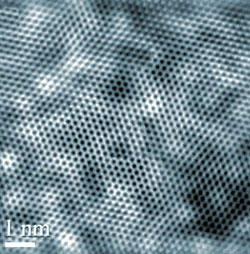| Posted: May 30, 2009 |
New route to make graphene sheets for flexible electronics |
|
(Nanowerk News) Chinese scientists have found a new route to high-quality graphene sheets for making flexible electronics ("Graphene sheets from worm-like exfoliated graphite" – free access article).
|
|
Hongwei Zhu and co-workers from Tsinghua University in Beijing developed a three-step process to synthesise the one atom-thick carbon sheets from worm-like expanded graphite (WEG). WEG consists of a tall stack of graphene sheets, expanded, but not fully separated into individual layers. Graphene is expected to eventually replace silicon in a revolutionary new breed of flexible electronics for applications including smart clothing, for example, health-monitoring sensors embedded in fabric, and foldable displays.
|
 |
| The graphene sheet, as seen through a high resolution transmission electron microscope
|
|
To make the WEG precursor, Zhu mixed natural graphite with sulfuric acid. The acid forced the graphite's layers apart to create a structure with graphite layers held together by sulfuric acid molecules. Zhu heated the resulting compound to decompose the acid, which increased the distance between the graphite sheets even further. He then exfoliated, or repeatedly peeled, the WEG product by ultrasonication and centrifugation to produce the single graphene layers. The graphene was not damaged by these processes; in fact, the individual layers produced were shown by Raman spectroscopy to be almost unchanged from their state in the natural graphite precursor.
|
|
|
|
'Our exfoliation approach combined with advances in the large scale manufacturing of WEG could lead to the development of new and more effective graphene products, for instance, carbon-based flexible electronics,' Zhu says, adding that his method would be easier and cheaper to scale up than existing techniques.
|
|
Hannes Schniepp, head of the Nanomaterials and Imaging Lab at The College of William and Mary, Virginia, US, agrees: 'Zhu has optimised the process to yield single-layer graphene sheets of remarkable quality. Having a pathway to produce macroscopic amounts of high-quality graphene is crucial for many applications, making use of its exciting electronic and mechanical properties.'
|

